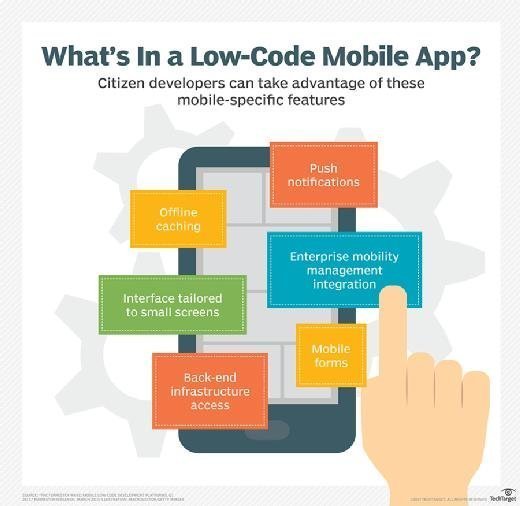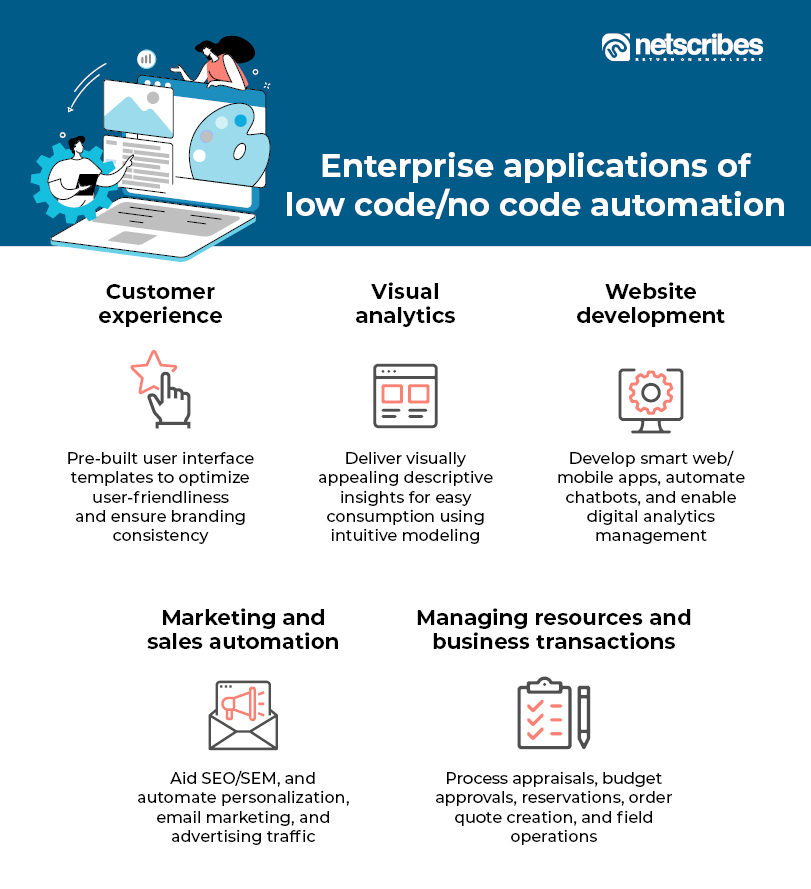New Info To Picking Low-code platforms for application development
New Info To Picking Low-code platforms for application development
Blog Article
Benefits Of Low-Code Application Development Terms Of Speed
Visual Development Environment:
Drag-and-Drop Interfaces: Low-code platforms provide visual tools for designing applications. Drag-and-drop elements enable developers to rapidly build applications without the need to write extensive code.
Many low-code platforms have built-in templates and components that enable developers to quickly test their apps and then build applications without starting with a blank slate.
Reduced Coding requirements:
Automated Code Generating: Low-code platform generates the code beneath based on the visual models that developers create. This reduces need for manual coding.
Reusable components: Developers are able to reuse components across a variety of projects, which decreases the time they're writing and testing code.
A more efficient collaboration
Integration of Development Tools: Low-code tools usually come with tools for version control as well as testing and deployment which facilitates seamless collaboration between development teams.
Citizen development: By using user-friendly interfaces and reducing bottlenecks often caused by the lack of developers, business users and non-developers are able to contribute towards application development.
Rapid prototyping and iteration:
Fast Prototyping : Developers create prototypes quickly to test ideas and collect feedback. This can result in a shorter iteration cycle.
Easy Modifications: The visually-oriented nature of low-code development makes it easier to make modifications and updates to applications, which accelerates the process of refining and improving applications based on feedback from users.
Pre-built Integrations:
API Integrations Low-code platforms include already built connectors that can be used with popular services or APIs. They cut down the time it takes to integrate external applications.
Data integration: Tools for data integration are included to help simplify the process.
Scaling and Deployment:
A lot of low-code platforms offer an option to deploy applications in one click, which reduces the time and effort required to deploy applications.
Cloud-Based Solution: Cloud based low code platforms are able to handle infrastructure management and scaling. This allows developers to focus more on applications' logic, functions and features rather than deployment logistics.
Low-code development of applications is a quicker method to create apps. It makes it easier and more efficient to automate several elements of the process. This allows for quicker delivery and adapting to changing requirements. Read the recommended Low-code Platform for application development for site advice including cross platform mobile app development, develop web app, no code platforms, cross platform app development, cross platform mobile development, cross platform app dev, build with docker, sso azure, push alerts, low code platforms and more.
Cost-Effectiveness Is Among The Many Advantages Of Developing Applications Using Low-Code.
Low-code applications offer a variety of advantages when it comes to cost-effectiveness. Businesses that are seeking to reduce costs can take advantage of this approach while also delivering high-quality applications. Here are a few of the most important advantages:
Low-Code Platforms: Low-code platforms minimize the amount of hand-coding required, which in turn saves developers time and energy in the process of creating applications. The result is lower labour costs.
Fewer Developers: Because low-code development is quicker and more simple and less complex, there are fewer developers needed. This will reduce the costs of recruiting and retaining personnel.
More Time To Market
Development speed up: Visual development tools and pre-built parts provided by platforms with low-code enable rapid application design, allowing companies to deliver products to market quicker. This could lead to quicker revenue growth and improved competitive positioning.
Rapid Prototyping: Businesses can quickly create prototypes and then test them, thus reducing the amount of time needed in the development stage and allows for quicker iterations based on feedback from users.
Lower maintenance costs:
Simplified Maintenance: Applications built with low-code platforms are typically easier to maintain due to their standard components and modular architecture. This means that they are less likely to require ongoing maintenance and support costs.
Automated Updates - Many low-code systems are capable of handling updates and patches in a way that is as secure as well as timely. This means there is no requirement for manual intervention.
Efficient Resource Utilization:
Contributions from non-developers: Low code platforms enable non-developers for example, business users to participate in the development process. This openness of development processes enables firms to make use of the skills and abilities of a broader number of employees.
Optimized Use of IT Resources: IT departments can focus on more strategic endeavors rather than being bogged down by routine tasks of development, improving overall efficiency and productivity.
Scalable Pricing Models
Subscription Pricing: A lot of platforms with low-code support different pricing options based on subscriptions that are scaled in accordance with the usage. This lets businesses be able to align their spending to their actual needs and increase their revenue, without incurring large upfront cost.
Pay-as-you-go options Certain platforms allow businesses to pay only for the services they use. This is particularly beneficial for small or new businesses with a limited budget.
Lowering Third-Party Costs of Software:
Low-code platforms typically come with integrated functionalities that eliminate the requirement to purchase additional tools or software. This can help you save cash on subscriptions and licensing costs.
Pre-Built integrations: These pre-built systems and services can be integrated with popular services, which reduces the need for custom-built software, and can save time and cost.
Increased ROI:
Increased Return on Investment Rapid development: By combining lower costs and a quicker time to market, businesses will see a greater ROI on their investments (ROI).
Increased Agility: Businesses are able to quickly adjust to changes in the market and to changing customer demands. This helps them remain current and take advantage of opportunities that come up.
Reduced Training Costs
User-Friendly Interfaces: The simple user-friendly interfaces offered by low-code platforms cut down on the learning curve of new users, and reduce the need for extensive training programs.
Accessible Resources. A lot of low-code platforms offer complete training materials, tutorials, as well community assistance. They reduce the need to attend formal training which can be expensive.
Collaboration streamlined:
Enhanced Collaboration Tools: The collaboration tools built-in to the software facilitate communication and coordination among team members. This results in more efficient project development and lower overhead.
Unified Development Environment : A unified environment streamlines workflows and cuts down on the expenses that are associated with managing different tools and platforms.
Overall, the cost-effectiveness of low-code development comes from its ability to cut maintenance and development costs as well as speed up time to market, optimize utilization of resources, as well as provide flexible pricing models. These aspects provide significant financial advantages to companies, making low code an appealing option for companies who want to make the most of their budgets and achieve solid, reliable, high-quality applications. View the top rated Legacy application modernization with Low-code for website recommendations including app development platform, mobile development platforms, push alerts, develop web application, lowcode no code, multiplatform mobile app development, microsoft azure sql, cross platform mobile development, rad application development, app platforms and more.
The Advantages Of Low-Code Development For Vendors And Community
Low-code platforms provide significant benefits in terms of community support and vendor support Both of which are vital to successful installation, maintenance and enhancement of software. Here are some of the major benefits: Support from vendors
Comprehensive Technical Support:
Dedicated Support Team: Many low code platforms have dedicated support staff who are available to help with technical queries in troubleshooting and guidance. They can ensure that problems are solved quickly.
24/7 Support Available: Certain companies provide 24/7 support which is particularly useful for businesses that operate globally and in various time zones.
Training and Onboarding
Structured Training: A number of companies offer structured training, including tutorials, webinars and certification classes to help users quickly become familiar with the platform.
Many companies offer customized onboarding to help customers utilize the platform effectively and adapt it to the needs of their customers.
Updates and Enhancements, Regularly and Enhancements:
Continuous Improvement Platform vendors typically release regular updates with new features, improvements to performance and security patches. This ensures that the platform stays up-to-date and secure.
Feedback Integration Vendors integrate user feedback into the process of development, making sure that the platform changes to meet changing needs.
Comprehensive Documentation:
Detailed Documentation: Extensive and well-organized documentation is typically available for download, covering everything from basics to advanced customization, which allows users to solve problems without assistance.
API References In-depth API documentation enables developers to modify applications and connect low-code platforms with other platforms.
Professional Consulting Services
Expert Consultation. Vendors offer a range of consulting services, including architectural design along with strategic planning and platform implementations. These services will ensure that users get the most out of their platform.
Custom Development Services A few vendors provide custom development services to create specific integrations and features that are not included in standard.
Community Support
Active User Communities
Forums and Discussion Panels: Many low-code platforms have vibrant online communities, which allow users to ask questions, discuss strategies, and even collaborate with one another on the best methods.
User Groups and Meetups: Local and virtual groups of users and meetups give you the chance to study about, network, and share experiences with others.
Collaboration and Knowledge Sharing
Community-Contributed Resources: Users often share templates, modules, and extensions that they have developed, which can be reused or adapted by others, accelerating development and innovation.
Crowdsourced Solution Finding: The collective wisdom and experience of a group could be a great resource for solving difficult problems.
Learning and Development:
Community-led training Community-led training: Many groups provide training sessions, webinars, and workshops facilitated by experts who are experts in their area.
Online Tutorials and Courses: The community members frequently publish online tutorials, classes, and tutorials for how to perform tasks that help students learn more.
Feedback and Influence
Product Feedback Channels: Community forums typically include channels for providing feedback to the vendor which may influence the design of new features and enhancements.
Beta Testing Programs: Members of the community who are active could be able to take part in beta testing programs that give them early access to new features as well as a say in determining the future of the platform.
Recognition and Encouragement
Community Recognition Programmes: Many companies offer recognition programs to active community members. Examples include MVP (Most Valuable Professionals), which recognizes the contribution of community members.
Peer Support Peer Support: Community members typically offer support to other members by sharing their expertise and offering guidance for those who aren't as experienced. This creates a supportive and supportive atmosphere.
Overall, the combination of robust vendor support and a vibrant connected community offers a comprehensive support ecosystem for the development of low-code applications. This means that users will have access to the resources knowledge, expertise, and collaborative opportunities required to effectively develop, deploy, and maintain their applications, ultimately enhancing efficiency and creativity.